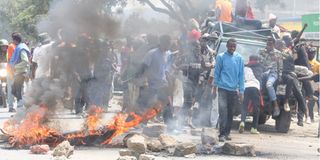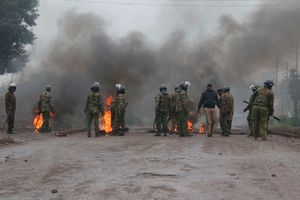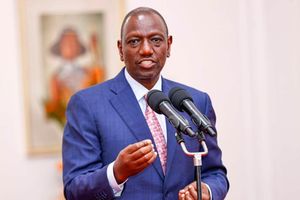
Protesters hang on a military Toyota Land Cruiser as they demonstrate at Free Area, on Nakuru-Nairobi highway on July 7, 2025.
It might not seem like it, but one of the forces that drove Kenya’s Gen Z protests of 2024 and 2025—and Monday’s Saba Saba demonstrations—is familiar: climate change.
Kenya, like much of Africa, is facing a warming world, with several countries enduring a brutal heatwave in the past year. At least 10 of them experienced three or more months in that period where daily temperatures exceeded 90 per cent of the 1991–2020 average, according to a just-released report, Climate Change and the Escalation of Global Extreme Heat, 2025.
Though not explicitly listed, Kenya faces similar climate pressures—perhaps worse—from droughts that parch its fields to floods that devastate communities, leaving families in Turkana, Mathare, and Nairobi grappling with hunger, loss, and uncertainty. Recent trends suggest these challenges are intensifying.
The 2022–2023 drought, among the most severe in decades, left 4.4 million Kenyans food insecure across 23 counties, with families unable to afford basic meals. The April–May 2024 floods claimed 238 lives and displaced over 200,000 people, particularly in Nairobi’s Mathare slums, where homes were destroyed and residents left to rebuild with little support.
Public frustration
These climate-driven pressures have fuelled public frustration—clearly visible in the 2024 Gen Z protests over the Finance Bill and the July 7, 2025, Saba Saba marches, where young Kenyans voiced growing concerns over the cost of living and joblessness. Kenya’s food import bill surged by 58 per cent in 2023, adding further strain on households already burdened by economic hardships.
These protests are not random. Many erupt around June and July—Kenya’s driest period. Crops fail, food prices spike, water becomes scarce, and rural youth migrate to towns seeking work that doesn’t exist. Youth unemployment remains above 15 per cent. Come November or February, when the rains return and the fields turn green, the heat—both climatic and political—subsides. It’s a reminder that the climate gods shape the country’s social and economic rhythms.
Kenya’s struggles echo those across Africa. In Egypt, drought-driven food price spikes contributed to the 2011 protests that toppled long-time strongman Hosni Mubarak. In Sudan, desertification and rural suffering helped spark the 2019 uprising that ousted dictator Omar al-Bashir.
By 2030, Kenya’s population may hit 60 million, placing further strain on food, water, and land systems. Yet its youth are inventive and can drive solutions—if given the opportunity. President William Ruto’s administration made a strong start in this regard, hosting the 2023 Africa Climate Summit and providing cash transfers to pastoralists. Building on these efforts, the country can pursue innovative strategies to improve food security.
One option is to deepen trade with East African neighbours like Uganda and Tanzania, which grow maize and vegetables under different weather patterns. In 2023, Kenya spent $200 million on maize imports from the East African Community (EAC), and experts suggest that streamlining regional trade could cut food prices by 15 per cent—lightening the load for Kenyan households.
Thinking outside the box, a Climate Basic Income—funded by carbon credits from Kenya’s forests, potentially worth $1 billion by 2030—could provide $50 monthly to 100,000 young people in drought-hit areas like Turkana. It would cost about $60 million a year, supporting families, education, and reforestation.
Jobless youth
Another idea is to develop Nomadic Food Hubs—solar-powered mobile units in pastoralist areas to preserve milk and meat—starting with pilot schemes in Turkana. Others propose Public Works Credits, where young people earn food or education vouchers by repairing roads or planting trees. Both could help reduce the flow of jobless youth into cities. There’s also room to hold Youth Climate Hackathons, inviting young Kenyans to develop local solutions—such as rainwater harvesting systems—empowering communities and showing that their ideas matter.
On a local level, Makueni County stands out as a model. Since 2011, it has promoted mango farming through improved seedlings and a processing plant. It now produces 38,000 metric tonnes annually, has trained 10,000 farmers, slashed fruit fly losses by 91.5 per cent, and created jobs through a local juice factory.
By integrating climate data into its development plans, Makueni has attracted climate finance to support community-led initiatives, such as water harvesting, helping vulnerable households adapt. President Ruto can’t change the weather—but he can change how Kenya responds to its consequences. Open up markets. Pay youth to stay rooted. Process food on the move. Let protesters dream up solutions. As ways to cool the streets, they’re as good as any.
The author is a journalist, writer, and curator of the "Wall of Great Africans". X@cobbo3









